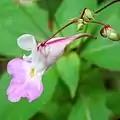Impatiens balfourii
Impatiens balfourii is a species of the genus Impatiens known by the common names Balfour's touch-me-not, Kashmir balsam,[1] and poor man's orchid. It belongs to the family Balsaminaceae.
| Impatiens balfourii | |
|---|---|
 | |
| Scientific classification | |
| Kingdom: | Plantae |
| Clade: | Tracheophytes |
| Clade: | Angiosperms |
| Clade: | Eudicots |
| Clade: | Asterids |
| Order: | Ericales |
| Family: | Balsaminaceae |
| Genus: | Impatiens |
| Species: | I. balfourii |
| Binomial name | |
| Impatiens balfourii | |
| Synonyms | |
| |
| Wikispecies has information related to Impatiens balfourii. |
| Wikimedia Commons has media related to Impatiens balfourii. |
Etymology
The Latin name Impatiens means "impatient" or "intolerant" and refers to the explosive dehiscence of the fruits, which burst at the slightest touch as a means of scattering the seeds. The Latin species epithet balfourii honors the Scottish botanist Isaac Bayley Balfour (1853-1922).[2]
Description
This is an annual herb growing 15–120 centimetres (5.9–47.2 in) in height. Its stem is glabrous, reddish, lined and very branched. It has alternately arranged, oval to lance-shaped, toothed, stalked leaves up to 4 centimetres (1.6 in) long. The inflorescence is a raceme generally bearing 4 to 8 flowers. Each flower is about 2 centimetres (0.79 in) long, with one of its white sepals forming a long, thin spur, and two of its yellow-dotted lavender or pink petals extending from the mouth.
Reproduction
The flowers are hermaphrodite, or perfect, and are pollinated by insects, or, in the Americas, by hummingbirds. The flowering period extends from July through September. The fruits are glabrous capsules about 20 millimetres (0.79 in) long and the seeds are dispersed when the fruits burst, launching them up to 6 metres (20 ft) away.
Distribution
It is native to the Himalayas, particularly Kashmir and surrounding areas, where it grows in mountains of 5,000 to 6,000 feet.[3] It was brought back to England and many other European countries as a garden plant, and then it became popular in the San Francisco Bay Area and other parts of the United States.[3] It can now be found growing wild as a garden escapee in Europe, on the US Pacific Coast, and in Wisconsin,[4] where it is well adapted to cool, wet sites.
Habitat
In the wild the plant occurs along the banks of rivers, on roadsides, and in wastelands. It thrives in cool and moist areas, at an altitude of 100–600 metres (330–1,970 ft) above sea level.
Gallery
 Form
Form Flower
Flower Long spur of the flower
Long spur of the flower Seeds
Seeds Leaf
Leaf
Notes
- "BSBI List 2007". Botanical Society of Britain and Ireland. Archived from the original (xls) on 2015-01-25. Retrieved 2014-10-17.
- Hooker, J.D. (1903) in Curtis's Botanical Magazine. vol. 129 tab. 7878
- Peirce, P. & D. Goldberg. Wildly Successful Plants: Northern California. Sasquatch Books. 2004. 75-77.
- USDA Plants Profile
References
- Pignatti, S. Flora d'Italia. Edagricole. 1982.
- Tutin, T. G., et al. Flora Europaea, second edition. 1993.